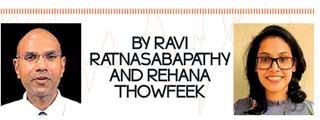20 Apr 2022 - {{hitsCtrl.values.hits}}

 Sri Lanka has just entered the deepest economic crisis in its history. Shortages and rising prices that people face today are only the first inkling of what lies ahead. Unless decisive action is taken, it can go into a destructive tailspin.
Sri Lanka has just entered the deepest economic crisis in its history. Shortages and rising prices that people face today are only the first inkling of what lies ahead. Unless decisive action is taken, it can go into a destructive tailspin.
Downgrades and forex shortages mean foreign banks will only accept upfront payments for imports until credibility is restored. This means the country is now in a hand-to-mouth existence: imports are restricted to the quantum of foreign exchange inflows. These inflows are shrinking.
Production of goods and services, for both exports and domestic consumption is contracting due to shortages of fuel, power and other inputs. Exporters are losing orders as overseas buyers, concerned about the inability to supply and missed deadlines are switching orders to other countries. Tourist numbers dwindle due to long power cuts, lack of fuel for transport and the closure of restaurants due to lack of gas.
Lower exports lead to even lower foreign exchange receipts, which in turn limits production even further. With each cycle, the noose tightens further, until eventually most activity ceases.
The shrinking supply of goods and services within the economy leads to increases in prices, as spending outpaces production. Businesses become unviable due to their inability to function at normal capacity and people lose their livelihoods. As activity shrinks, individuals and businesses alike find it difficult to repay their bank loans and the pressure shifts to the banking sector. This cycle continues until most economic activity grinds to a halt. As the country is pushed into a subsistence existence malnutrition and hunger become widespread.
The crippling effects of the inability to import are similar to that of being under international sanctions except that these have been self-inflicted. Now that the downward cycle has started, it is very difficult to stop as the forces of destruction gather momentum and speed. Until the appointment of the new governor last week, Sri Lanka was in free-fall. The best hope now is to arrest the descent and stabilise it at some point. The governor has taken only the first step on the path to stabilisation but much more needs to be done.
It is clear from the people’s protests that the public have lost confidence in the government. What people don’t realise is that multilateral agencies, international banks and rating agencies have also lost confidence. The government budgets the last two years were replete with errors: overestimated revenues, irreconcilable differences and unrealistic assumptions. Abrupt changes in polices and asinine statements by officials underlined these concerns; one international bank entitled its update “Denial is not a Strategy”. Even before the default many foreign banks refuse to accept letters of credit from Sri Lankan banks unless guaranteed by an international bank.
A key benefit of an International Monetary Fund (IMF) programme is that it will restore confidence. The mere fact that the government budgets and forecasts are being reviewed by the IMF signals that they are based on realistic assumptions and reasonable estimates. Together with concrete steps towards repairing public finances it will restore some confidence among lenders and pave the way for bridge finance – to relieve some of the crippling shortages that are choking production and livelihoods.
Returning to growth is not impossible but this means addressing the structural issues within the economy, a matter that is all but impossible due to the thicket of vested interests that have grown during the past two decades.
Stabilisation – averting complete meltdown
The major cause of the disequilibrium in the economy was the excessive money printing carried out by the Central Bank since 2019. Money has been printed to finance government expenditure at an alarming rate. The huge increase in government spending results in strong demand for goods and services within the economy. High levels of demand feed into local products and services as well as for imports. Historically, whenever the government has run a large budget deficit financed by the Central Bank credit, it has always resulted in a current account deficit.
The first step to addressing the problem of money printing is to borrow from the domestic market, instead of the Central Bank. Given the enormous sums being borrowed, the government needs to offer a sufficiently high interest rate to attract the required quantum of funds. This is why rates have been raised sharply. Higher rates will reduce consumption by the private sector (which also reduces imports) but may also affect investment, so such high rates, while unavoidable to stabilise the present situation, cannot be maintained in the long term.
For rates to reduce, the levels of government borrowing must reduce. This means cutting the budget deficit. This will have to be approached in two ways: an increase in taxes and a reduction in expenditure.
Increases in personal taxes will reduce the government deficit and therefore the government borrowing requirement reducing the pressure on interest rates. Higher taxes can help curtail private consumption (including import consumption) but may also impact savings and therefore investment. Increases in corporate taxes could curtail investment.
To minimise the negative effect on investment, the government should not rely on taxes alone, expenditure must be cut but the recurrent expenditure is very rigid (mainly salaries, interest and pensions), so reducing capital expenditure is more feasible both politically and practically. Resistance will however be encountered due the corruption involved, especially in highway projects. Reducing the drain from state enterprises and the disposal of idle or underutilised assets are other avenues to close the deficit. Some trimming of unnecessary current government expenditures can increase available fiscal space for social transfers.
Since the majority of the government expenditure is spent on salaries, pensions and interest, a recruitment freeze and a freeze on increments will halt further expansion. All discretionary expenditure unless directly welfare related must be frozen along with capital expenditure at least in the short term. All transfers and support to state-owned enterprises must cease.
The imbalances will be resolved due to a combination of factors: contraction of demand due to higher interest rates and higher prices which follow from the adjustment of prices to the realistic exchange rate. Prices will need to rise to the market clearing rate, critically energy prices, which are dependent on the exchange rate. This, however, delivers a huge negative shock to the poor, so it must be cushioned with social transfers.
These are purely stabilisation measures. If carried out properly, this can restore the economy to its state in 2019 but at a higher price level, higher unemployment, lower levels of output and higher levels of poverty. Those in the middle and lower-income groups will be pushed further down the income spectrum: large sections of the middle class will find themselves poor and the poor will be left in abject poverty. Due to low levels of productivity growth will be stagnant at 1-2 percent.
Some of the destruction that has been wrought on businesses will be permanent. The rate of increase in prices will slow to tolerable levels but prices for the most part will not decline from the current high levels. Lower incomes and high prices lead to much lower living standards for most people. The low levels of productivity within the economy mean that prospects for escaping poverty remain poor but on the positive side, things will stop getting worse.
If people are to have some hope, then growth needs to be restored, which means addressing the problem of productivity.
Growth – Restoring prospects to recovery
The people will have little prospects unless growth returns but growth is impossible unless the barriers that impede it are addressed.
Sustained economic growth and productivity improvement are intricately linked. These are two sides of the same coin: a faster rate of economic growth cannot be maintained without productivity improvement. Higher productivity must be achieved in all sectors of economy, including the government, public sector and agriculture, where it is weakest.
At its simplest, productivity is a measure of an economy’s ability to produce outputs (goods and services) from a given set of inputs. The more productive the economy, the more value it is able to generate, either through more efficient allocation of inputs, greater productive efficiency in converting inputs into outputs or through innovation – coming up with new products and processes. Achieving sustained economic growth ultimately depends on an economy’s ability to increase its productivity over time, so improving productivity should be the key long-term goal of economic policy.
Many of the barriers to increased productivity are the result of policies and regulations of past governments. Misguided or poorly implemented measures to protect or encourage particular sectors have stifled the competitive forces that drive productivity resulting in higher costs of production. Competitive intensity is a key driver of productivity. It is only in a highly competitive business environment that firms have strong incentive to adopt best-practice techniques, technology and engage in innovative activity. This works in three main ways.
First, within firms, competition acts as a disciplining device, placing pressure on the managers to become more efficient. Secondly, competition ensures that more productive firms increase their market share at the expense of the less productive. These low productivity firms may then exit the market, to be replaced by higher productivity firms. Thirdly and perhaps most importantly, competition drives firms to innovate, coming up with new products and processes, which can lead to step-changes in efficiency. Protectionism shields them from these competitive forces and eliminates a vital incentive, stunting long-term growth.
Increasing competition means opening the country to investment and trade, reducing the tariffs and regulatory impediments to both. This can help reduce consumer prices and prices of inputs. Import competition spurs local businesses to greater efficiency. With sound macroeconomic policies in place imports can flow in freely.
Within the government, productivity must be addressed through the process of privatisation of commercial activities that could be more productively undertaken by the private sector and the closing down of non-viable state-owned entities, reforming the legal foundations of the economy and substantially increasing the efficiency in critical government functions. For example, increasing the efficiency in the areas of tax and custom procedures and reducing trade and regulatory barriers to enhance competitiveness, digitisation and better systems that improve efficiency and ease of doing business.
Policymakers have no idea of how grave this crisis is or how bad things could get. It is a classic debt and balance of payments crisis, which, if mishandled, can result in a complete meltdown of the economy. The government has appointed, at long last, competent officials in the governor and the treasury secretary aided by a solid team in Indrajith Coomaraswamy, Shanta Devarajan and Sharmini Cooray. They must have unwavering support from the executive and legislature. All political parties need to work together towards resolving the political deadlock and restoring political stability to ensure economic change can be achieved without delay.
08 Jan 2025 28 minute ago
08 Jan 2025 1 hours ago
08 Jan 2025 3 hours ago
08 Jan 2025 4 hours ago